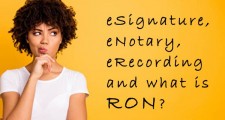
Lending lingo every lending professional should know.
WEST DES MOINES, Iowa, October 30, 2019 (Newswire.com) - LenderClose's CEO, Omar Jordan, sat down for an interview with Mike Lawson of CU Broadcast. The goal was to help eliminate some of the confusion around new terminology springing up as the digital mortgage and home equity lending grows in popularity.
Jordan recognized the need for clarity as he encountered different people on the road to legalizing remote online notarization (RON) in Iowa. In meetings with the state’s governor, Jordan, LenderClose COO Ben Rempe and a team of individuals helped lead Iowa in becoming the 10th state to pass a RON bill.
Senate File 475 will go into effect July 1, 2020.
Progress won’t stop there. The entire LenderClose team is excited about continued involvement in conversations with legislators to ensure the rule-writing process is done properly and in a lender and borrower-friendly way.
In the CU Broadcast interview, Jordan made it clear that credit unions and other lending institutions that aspire to be on the leading edge of lending’s digital transformation have to be aware of the definitions around four technologies in particular: eNotary, RON, eSignature and eRecording.
eNotary: A lender’s notary public and the borrower are in the same room so the borrower’s ID can be validated in person and per state guidelines. However, the signature is realized electronically, and the notary stamp is done digitally, rather than with a physical stamp.
Remote Online Notarization (RON): Parties are not in the same room, as the RON occurs via a recorded video conference. That conference includes the notary, the borrower and a witness and/or another party the transaction may require. Rules around ID validation vary by state and include specific measures that ensure validation is done properly. In most cases, the borrowers’ ID is validated through a Knowledge-Based Authentication (KBA) method.
eSignature: An eSignature transaction is completed on an electronic device, such as a tablet (think: DocuSign). Signing electronically or clicking to sign is as legally valid as a handwritten signature, sometimes referred to as a “wet signature.”
eRecording: When a lender has closed a real estate loan, a deed of trust or mortgage document has to be recorded. Rather than snail mail the documents to the county recorder and wait four to seven days for it to be recorded, eRecording allows the documents to be submitted securely and electronically
The impact of new technology on credit unions and other lenders
Omar pointed out that lending industry processes haven’t meaningfully changed since the 1930s. Each of the digital technologies listed above brings a greater degree of both speed and convenience – essential for lenders to stay relevant and attract the next generation of borrowers.
Today’s borrower is looking for easy. Having to come into a branch office to sign paperwork may prevent some borrowers and some businesses from doing business simply because they are too busy; others have physical restrictions that make it difficult to get in to see a lender.
Source: LenderClose
Share:
